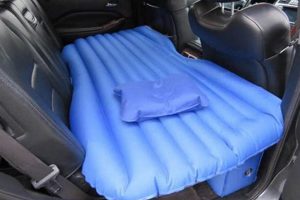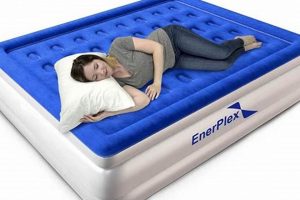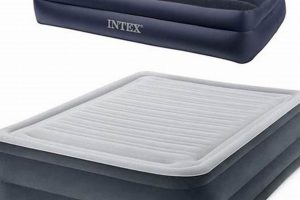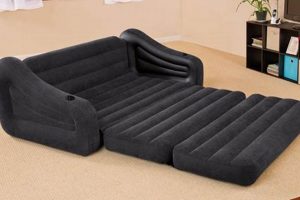A conforming, air-filled pad designed to be placed on top of an existing mattress. This provides an additional layer of cushioning and support. As an example, individuals might use this product to enhance the comfort of a firm mattress or to alleviate pressure points during sleep.
These additions to mattresses offer several advantages, including improved sleep quality, reduced back pain, and enhanced pressure redistribution. Their development is rooted in the need for cost-effective solutions to enhance mattress comfort and accommodate individuals with specific medical requirements. They offer a practical alternative to replacing an entire mattress.
The following sections will delve into the specific types, applications, and considerations involved in selecting and utilizing mattress enhancements, providing a detailed understanding of their role in sleep optimization and pressure relief.
Air Mattress Overlay
The following guidance ensures proper setup, maintenance, and optimal utilization of air mattress enhancements, maximizing their longevity and benefits.
Tip 1: Verify Compatibility. Ensure the overlay dimensions are appropriate for the existing mattress. Overhang or insufficient coverage can compromise support and increase the risk of damage.
Tip 2: Inflate Appropriately. Over-inflation may cause bursting or reduce the conformance. Under-inflation defeats the purpose. Always follow manufacturer guidelines for optimal air pressure.
Tip 3: Protect Against Sharp Objects. These overlays are susceptible to punctures. Avoid placing them on surfaces with sharp edges and keep pets with sharp claws away from the surface.
Tip 4: Use a Mattress Protector. Place a thin, breathable mattress protector over the overlay. This shields against spills, stains, and allergens, thereby extending its lifespan.
Tip 5: Rotate Regularly. Regular rotation, similar to mattress rotation, promotes even wear and distributes pressure, enhancing durability and comfort.
Tip 6: Clean Carefully. Adhere to manufacturer cleaning instructions. Avoid harsh chemicals, and ensure complete dryness before storage or reuse to prevent mold or mildew.
Tip 7: Store Properly. When not in use, deflate completely, roll it, and store in a cool, dry location away from direct sunlight or extreme temperatures, which can degrade the material.
Following these guidelines preserves product integrity, ensuring consistent performance and extending the lifespan of the air mattress enhancement.
The succeeding section will address specific considerations related to the selection and troubleshooting of these pressure-redistributing devices.
1. Pressure Redistribution
Air mattress overlays are designed to mitigate pressure concentrations on the body during sleep or extended periods of rest. This is achieved through the displacement of air within the overlay’s internal chambers, conforming to the user’s contours and distributing weight more evenly across the support surface. A lack of adequate pressure redistribution can lead to localized ischemia, potentially resulting in discomfort, pain, and, in severe cases, pressure ulcers. An example is the use of alternating pressure overlays in hospitals to prevent pressure sores in immobilized patients.
The effectiveness of pressure redistribution varies based on design and materials. Overlays with interconnected air cells facilitate dynamic redistribution as the user shifts position, whereas simpler designs offer a static level of support. Furthermore, the overlay’s material elasticity and thickness contribute significantly to its ability to conform to the body without creating new pressure points. For instance, a thicker overlay with a softer material will generally offer better pressure relief than a thin, rigid alternative. The understanding of these design considerations allows for selection of the most appropriate overlay to maximize patient comfort and minimize risks of pressure-related complications.
In summary, pressure redistribution is a foundational attribute of the air mattress overlay, playing a pivotal role in its therapeutic and comfort-enhancing properties. The ability to effectively minimize pressure concentrations is directly related to the overlay’s design, materials, and inflation level. Ensuring adequate pressure redistribution remains a key consideration when selecting and utilizing these devices, particularly for individuals at risk of developing pressure injuries.Selecting the proper air mattress overlay is a complex decision, one that must be customized based on individual requirements. Additional factors to consider are weight, lifestyle, health concerns and personal preference.
2. Material Composition
The selection of materials significantly influences the performance, durability, and safety profile of air mattress overlays. The inherent properties of the chosen materials dictate the overlay’s ability to maintain air pressure, resist wear and tear, and provide a comfortable sleep surface. Understanding material composition is therefore critical for evaluating the suitability of an air mattress overlay for specific needs.
- Polyvinyl Chloride (PVC)
PVC is commonly employed due to its cost-effectiveness and ability to be easily sealed. However, PVC may off-gas volatile organic compounds (VOCs), potentially affecting air quality. Its durability varies depending on the thickness and quality of the PVC used. Lower-grade PVC may be susceptible to punctures and tears, reducing the overlay’s lifespan. Phthalate plasticizers are also found in many PVC formulations, which are under scrutiny for potential health concerns.
- Thermoplastic Polyurethane (TPU)
TPU offers enhanced durability and flexibility compared to PVC. It exhibits superior resistance to abrasion, punctures, and tearing. Furthermore, TPU is generally considered to be more environmentally friendly than PVC, as it does not contain phthalates and can be recycled. Overlays made with TPU tend to be more expensive but offer a longer lifespan and improved performance.
- Nylon and Polyester Fabrics
These fabrics are often used as a coating or laminated layer on the air mattress overlay to improve comfort and durability. Nylon provides high strength and abrasion resistance, while polyester offers good resistance to stretching and shrinking. These fabrics can also be treated with antimicrobial finishes to inhibit the growth of bacteria and mold, improving hygiene.
- Adhesives and Sealants
The adhesives and sealants used to bond the different layers of the air mattress overlay play a crucial role in maintaining air tightness and structural integrity. The type of adhesive used must be compatible with the other materials and resistant to degradation from humidity, temperatur
e fluctuations, and repeated inflation and deflation cycles. Failures in the adhesive bonds can lead to air leaks and premature failure of the overlay.
In summary, the material composition of an air mattress overlay is a complex interplay of factors influencing its performance, longevity, and safety. The selection of appropriate materials requires careful consideration of the intended use, budget constraints, and environmental concerns. A thorough understanding of the properties and limitations of different materials allows for an informed decision, ensuring that the chosen air mattress overlay meets the specific needs and expectations of the user. Furthermore, consideration should be given to the manufacturing processes employed, as these can influence the final product’s characteristics and environmental impact.
3. Inflation System
The inflation system is an integral component of any air mattress overlay, directly dictating its functionality and performance. The primary function of the inflation system is to introduce air into the overlay’s internal chambers, thereby providing the necessary support and pressure redistribution characteristics. A malfunction or inefficiency in the inflation system negates the overlay’s intended benefits, rendering it unusable. For instance, an overlay with a faulty valve may slowly deflate, resulting in a gradual loss of support and a diminished ability to relieve pressure points. Similarly, a system lacking precise pressure control might lead to over-inflation, compromising comfort and potentially damaging the overlay’s structure.
Inflation systems vary in complexity and technology. Basic overlays utilize manual pumps or external electric pumps to inflate the air chambers. More advanced systems incorporate integrated electric pumps with automatic pressure sensors and adjustment capabilities. These sophisticated systems maintain a consistent pressure level, compensating for minor air leaks or changes in user weight distribution. A practical example is the use of closed-loop feedback control in medical-grade air mattress overlays, where pressure sensors continuously monitor and adjust the internal pressure to ensure optimal pressure relief for patients at risk of pressure ulcers. The efficiency, reliability, and control precision of the inflation system are thus critical factors in determining the overall effectiveness of the air mattress overlay.
In summary, the inflation system is not merely a supplementary feature but a fundamental aspect of the air mattress overlay, directly influencing its performance, therapeutic benefits, and longevity. The selection of an overlay should include careful consideration of the inflation system’s design, reliability, and control capabilities. Understanding the interplay between the inflation system and the overlay’s overall function is essential for maximizing user satisfaction and realizing the intended pressure-redistributing benefits. Challenges such as maintaining system durability and ensuring consistent pressure regulation remain areas of ongoing development and improvement. Selecting an overlay based on weight, lifestyle, medical conditions, and doctor’s recomendations is important.
4. Surface Texture
The surface texture of an air mattress overlay directly influences user comfort, hygiene, and overall effectiveness. A smooth, non-porous surface minimizes friction, reducing the risk of skin irritation and pressure sore development, particularly for individuals with limited mobility. Conversely, a rough or uneven surface can exacerbate pressure points, negating the intended benefits of pressure redistribution. For example, overlays designed for hospital use often feature a smooth, coated surface to facilitate cleaning and disinfection, minimizing the risk of cross-contamination.
The selection of an appropriate surface texture also impacts airflow and moisture management. A textured surface, such as one with embossed channels, promotes air circulation between the overlay and the user’s skin, reducing humidity and preventing the build-up of perspiration. This is particularly important for individuals who are prone to excessive sweating or live in humid environments. Furthermore, the surface texture affects the grip between the overlay and the underlying mattress, preventing slippage and ensuring stability. An overlay with inadequate grip can shift during use, compromising support and increasing the risk of falls.
In summary, surface texture is not merely an aesthetic consideration but a functional attribute that significantly impacts the comfort, hygiene, and safety of an air mattress overlay. The selection of an appropriate surface texture should be based on the user’s individual needs and preferences, as well as the intended application. Balancing the need for a smooth, easy-to-clean surface with the benefits of enhanced airflow and grip requires careful consideration. Ongoing research and development in material science continue to refine surface textures, optimizing their performance and addressing the challenges associated with pressure redistribution and user comfort.
5. Size Compatibility
The dimension match between an air mattress overlay and the underlying mattress is crucial for optimal performance and safety. Mismatched sizes can compromise support, increase the risk of falls, and reduce the overall lifespan of both the overlay and the mattress.
- Width Discrepancies
If the overlay is narrower than the mattress, edge support is reduced, potentially leading to discomfort and instability. A too-wide overlay can bunch up, creating uneven pressure distribution and increasing wear and tear. For example, placing a twin-sized overlay on a full-sized mattress results in significant portions of the mattress remaining unprotected, negating the benefits of the overlay in those areas.
- Length Mismatches
An overlay that is too short leaves the feet or head unsupported, diminishing comfort and potentially exacerbating pressure points. Overlong overlays can fold over the edges, creating tripping hazards and causing premature material degradation. A queen-sized overlay used on a twin mattress would exhibit excessive overhang, rendering the setup impractical and potentially dangerous.
- Thickness Considerations
While not a direct size compatibility issue, the overlay’s thickness should be considered in relation to the mattress and bed frame. An excessively thick overlay on an already tall mattress may make it difficult to get in and out of bed, particularly for individuals with mobility limitations. Conversely, a very thin mattress and very thin overlay may not provide enough support.
- Attachment Mechanisms
Even if the overlay dimensions are correct, incompatible attachment mechanisms can lead to shifting and displacement during use. Elastic straps or corner anchors must be appropriately sized and positioned to securely hold the overlay in place. An overlay with poorly designed or missing attachments may slide off the mattress, reducing its effectiveness and creating a safety hazard.
Therefore, precise adherence to size specifications is paramount when selecting an air mattress over
lay. Verifying the dimensions of both the overlay and the underlying mattress ensures proper fit, maximizing comfort, support, and safety. Careful consideration of these aspects optimizes the benefits of the overlay while mitigating potential risks associated with size incompatibility.
6. Therapeutic Applications
Air mattress overlays serve specific therapeutic functions, primarily in pressure redistribution for individuals at risk of pressure ulcers. The conforming nature of the air-filled cells reduces concentrated pressure on bony prominences. For instance, patients with limited mobility, spinal cord injuries, or those recovering from surgery often benefit from these overlays to prevent tissue breakdown. The dynamic redistribution of pressure, achieved through alternating inflation and deflation cycles in some models, further minimizes prolonged pressure exposure. This proactive intervention is essential in healthcare settings to mitigate the incidence of pressure injuries, thereby reducing patient morbidity and associated treatment costs.
Beyond pressure ulcer prevention, air mattress overlays find applications in pain management. The adjustable firmness allows customization of support, catering to individual needs and preferences. For example, individuals with chronic back pain or arthritis may experience relief by adjusting the overlay’s inflation level to achieve optimal spinal alignment and minimize joint stress. The therapeutic effectiveness hinges on proper usage, including appropriate inflation levels and regular inspection for damage. Failure to adhere to these guidelines can compromise the overlay’s functionality and negate its intended benefits. Furthermore, the overlay’s material composition and surface texture play a role in its therapeutic efficacy, influencing factors such as breathability and friction against the skin.
In conclusion, the therapeutic applications of air mattress overlays extend beyond mere comfort enhancement, providing tangible benefits in pressure ulcer prevention and pain management. Their effectiveness relies on a combination of factors, including design features, proper usage, and individual patient characteristics. While these overlays offer a valuable tool in healthcare and home settings, their application should be informed by clinical guidelines and tailored to the specific needs of the individual. Ongoing research continues to explore novel designs and materials to further optimize the therapeutic potential of air mattress overlays.
Frequently Asked Questions
The following addresses common inquiries regarding the selection, use, and maintenance of air mattress overlays, providing clarity on various aspects of these sleep surface enhancements.
Question 1: What is the expected lifespan of an air mattress overlay?
Lifespan is variable, influenced by factors such as material quality, usage frequency, and maintenance practices. Higher-grade overlays, properly maintained, may last for several years. Damage, improper cleaning, or excessive weight can shorten the lifespan.
Question 2: Can an air mattress overlay be used on any type of mattress?
Most mattress overlays are designed for compatibility with standard innerspring, memory foam, and hybrid mattresses. However, specific recommendations vary by manufacturer. It is advisable to verify the overlay’s compatibility with the existing mattress type and size before purchase.
Question 3: How is an air mattress overlay cleaned?
Cleaning protocols depend on the overlay’s material composition. Typically, a mild soap solution and a damp cloth are recommended. Harsh chemicals or abrasive cleaners should be avoided. Thorough drying is essential to prevent mold or mildew growth.
Question 4: What is the weight capacity of a typical air mattress overlay?
Weight capacity varies significantly among different models. Lower-end overlays may have a capacity of 250 pounds, while higher-end models can support up to 500 pounds or more. Exceeding the specified weight limit can damage the overlay and compromise its support.
Question 5: Are air mattress overlays effective for preventing pressure ulcers?
Air mattress overlays designed with pressure redistribution technology can aid in pressure ulcer prevention, particularly for individuals with limited mobility. Alternating pressure models are often recommended in clinical settings. However, their effectiveness depends on appropriate usage and adherence to other preventive measures.
Question 6: What are the potential drawbacks of using an air mattress overlay?
Potential drawbacks include susceptibility to punctures, the need for inflation maintenance, and the possibility of off-gassing from certain materials. Some users may also find the texture or feel of an air mattress overlay to be less comfortable than traditional mattress surfaces.
In summary, air mattress overlays can provide a beneficial enhancement to sleep surfaces, but awareness of their limitations and adherence to proper usage guidelines are essential for optimal performance and longevity.
The subsequent section will explore advanced features and technological innovations in air mattress overlay design.
Conclusion
This exploration has elucidated the multifaceted nature of the air mattress overlay, encompassing its design features, therapeutic applications, and maintenance considerations. Key aspects, including pressure redistribution, material composition, inflation systems, surface texture, and size compatibility, underscore the critical role this sleep surface enhancement plays in optimizing comfort, promoting hygiene, and mitigating the risk of pressure-related complications.
Continued research and technological advancements promise further refinements in air mattress overlay design, materials, and functionality. A discerning approach to selection, informed by individual needs and professional guidance, remains paramount in realizing the full potential of these devices. The ongoing pursuit of innovation within this field holds significant implications for enhancing patient care, improving sleep quality, and promoting overall well-being.







